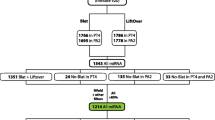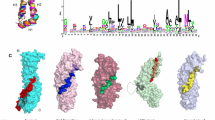Summary
The dimeric Alu molecule of human and other primates is composed of a left and a right arm that are very similar but show characteristic differences. If the Alu sequence has arisen through the fusion of monomeric precursor molecules, the traces of such precursor genes are expected still to be present in contemporary primate DNA. We report finding seven independent human DNA sequences that qualify s descendants of a left-arm precursor gene. Some characteristics in primary and secondary structures of these sequences are described.
Similar content being viewed by others
References
Bains W (1986) The multiple origins of human Alu sequences. J Mol Evol 23:189–199
Britten RJ, Baron WF, Stout D, Davidson EH (1988) Sources and evolution of human Alu repeated sequences. Proc Natl Acad Sci USA 85:4770–4774
Britten RJ, Stout D, Davidson EH (1989) The current source of human Alu retroposons is a conserved gene shared with Old World monkey. Proc Natl Acad Sci USA 86:3718–3722
Buckler CE, Salzman NP (1986) Annotated nucleotide sequence and restriction site lists for selected papovavirus strains. In: Salzman NP (ed) The Papovaviridae, vol I. Plenum, New York, pp 379–446
Chen M-J, Shimada T, Moulton AD, Cline A, Humphries RK, Maizel J, Nienhuis AW (1984) The functional human dihydrofolate reductase gene. J Biol Chem 259:3933–3943
Cotter RL, McPhie P, Gratzer WB (1967) Internal organization of the ribosome. Nature 216:864–868
Daniels GR, Deininger PL (1985) Integration site preferences of the Alu family and similar repetitive DNA sequences. Nucleic Acids Res 13:8939–8954
Degen SJF, Rajput B, Reich E (1986) The human tissue plasminogen activator gene. J Biol Chem 261:6972–6985
Deininger PL, Daniels GR (1986) The recent evolution of mammalian repetitive DNA elements. Trends Genet 2:76–80
Emi M, Wu LL, Robertson MA, Myers RL, Hegele RA, Williams RR, Lalouel J-M (1988) Genotyping and sequence analysis of apolipoprotein E isoforms. Genomics 3:373–379
Evans MJ, Scarpulla C (1988) The human somatic cytochrome gene: two classes of processed pseudogenes demarcate a period of rapid molecular evolution. Proc Natl Acad Sci USA 85: 9625–9629
Faulkner DV, Jurka J (1988) Multiple aligned sequence editor (MASE). Trends Biochem Sci 13:321–322
Gundelfinger ED, Di Carlo M, Zopf D, Melli M (1984) Structure and evolution of the 7SL RNA component of the signal recognition particle. EMBO J 2:2325–2332
Gutell RR, Weiser B, Woese CR, Noller HF (1985) Comparative anatomy of 16-S-like ribosomal RNA. Prog Nucleic Acid Res Mol Biol 32:155–217
Harada F, Kato N (1980) Nucleotide sequences of 4.5S RNAs associated with poly (A)-containing RNAs of mouse and hamster cells. Nucleic Acids Res 8:1273–1285
Jelinek WR, Toomey TP, Leinwand L, Duncan CH, Biro PA, Choudary PV, Weissman SM, Rubin CM, Houck CM, Deininger PL, Schmid CW (1980) Ubiquitous, interspersed repeated sequences in mammalian genomes. Proc Natl Acad Sci USA 77:1398–1401.
Johnson EM, Jelinek WR (1986) Replication of a plasmid bearing a humanAlu-family repeat in monkey COS-7 cells. Proc Natl Acad Sci USA 83:4660–4664
Jurka J (1990) Novel families of interspersed repetitive elements from the human genome. Nucleic Acids Res 18:137–140
Jurka J, Milosavljevic A (1991) Reconstruction and analysis of human Alu genes. J Mol Evol 32:105–121
Jurka J, Smith T (1988) A fundamental division in the Alu family of repeated sequences. Proc Natl Acad Sci USA 85: 4775–4778
Labuda D, Striker G (1989) Sequence conservation in Alu evolution. Nucleic Acids Res 17:2477–2491
Li W-Y, Ram R, Henning D, Epstein P, Busch H (1982) Nucleotide sequences of 7S RNA. J Biol Chem 257:5136–5142
Mancuso DJ, Tuley EA, Westfield LA, Worral NK, Shelton-Inloes BB, Sorace JM, Alevy YG, Sadler JE (1989) Structure of the gene for human von Willebrand factor. J Biol Chem 25:19514–19527
Marchuk D, McCrohon S, Fuchs E (1985) Complete sequence of a gene encoding a human type I keratin: sequences homologous to enhancer elements in the regulatory region of the gene. Proc Natl Acad Sci USA 82:1609–1613
Neckelmann N, Warner CK, Chung A, Kudoh J, Minoshima S, Fukuyama R, Maekawa M, Shimizu Y, Shimizu N, Liu JD, Wallace DC (1989) The human ATP synthase β subunit gene: sequence analysis, chromosome assignment and differential expression. Genomics 5:829–843
Quentin Y (1988) The Alu family developed through successive waves of fixation closely connected with primate lineage history. J Mol Evol 27:194–202
Quentin Y (1989) Succesive waves of fixation of B1 variants in rodent lineage history. J Mol Evol 28:299–305
Reeves SA, Helman LJ, Allison A, Israel M (1989) Molecular cloning and primary structure of human glial fibrillary acidic protein. Proc Natl Acad Sci USA 86:5178–5182
Rogers JH (1985) The origin and evolution of retroposons. Int Rev Cytol 93:187–279
Savtchenko ES, Freedberg IM, Choi I-Y, Blumenberg M (1988) Inactivation of human keratin genes: the spectrum of mutations in the sequence of an acidic keratin pseudogene. Mol Biol Evol 5:97–108
Siegel V, Walter P (1986) Removal of the Alu structural domain from signal recognition particle leaves its protein translocation activity intact. Nature 320:81–84
Sinnet D, Richer C, Deragon JM, Labuda, D (1991)Alu RNA secondary structure consists of two independent 7SL RNA-like folding units. J Biol Chem (in press)
Slagel V, Flemington E, Traina-Dorge V, Bradshaw H, Deininger P (1987) Clustering and subfamily relationships of the Alu family in the human genome. Mol Biol Evol 4:19–29
Smith TF, Waterman MS (1981) Identification of common molecular subsequences. J Mol Biol 145:195–197
Toyonaga B, Yoshikai Y, Vadasz V, Chin B, Mak TW (1985) Organization and sequences of the diversity, joining, and constant region genes of the human T-cell receptor β-chain. Proc Natl Acad Sci USA 82:8624–8628
Ullu E, Tschudi C (1984) Alu sequences are processed 7SL RNA genes. Nature 312:171–172
Ullu E, Weiner AM (1984) Human genes and pseudogenes for the 7SL RNA component of signal recognition particle. EMBO J 3:3303–3310
Walter P, Gilmore R, Blobel G (1984) Protein translocation across the endoplasmic reticulum. Cell 38:5–8
Watson JB, Sutcliffe JG (1987) Primate brain-specific cytoplasmic transcript of the Alu repeat family. Mol Cell Biol 7: 3324–3327
Wilbur WJ, Lipman DJ (1983) Rapid similarity searches of nucleic acid and protein data bases. Proc Natl Acad Sci USA 80:726–730
Willard C, Nguyen HT, Schmid CW (1987) Existence of at least three distinct Alu subfamilies. J Mol Evol 26:180–186
Zwieb C (1985) The secondary structure of the 7SL RNA in the signal recognition particle: functional implications. Nucleic Acids Res 13:6105–6124
Author information
Authors and Affiliations
Rights and permissions
About this article
Cite this article
Jurka, J., Zuckerkandl, E. Free left arms as precursor molecules in the evolution of Alu sequences. J Mol Evol 33, 49–56 (1991). https://doi.org/10.1007/BF02100195
Issue Date:
DOI: https://doi.org/10.1007/BF02100195




